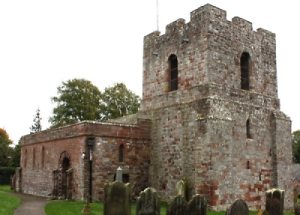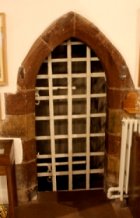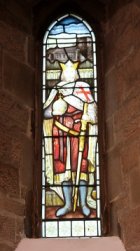St Michael's Church, Burgh-By-Sands
 7 July 1307 (07.07.07) is a key date in English history – the death of King Edward I.
The small medieval church of St Michael's in Burgh-by-Sands, Cumbria played a role that day that would forever guarantee it a place in medieval history. The church was where the body of the king was brought to lie in state after he had died of dysentery on the Solway Firth marshes. He had been en route to do battle with Robert the Bruce of Scotland. A stained-glass window in the church as it is today commemorates this fact.
7 July 1307 (07.07.07) is a key date in English history – the death of King Edward I.
The small medieval church of St Michael's in Burgh-by-Sands, Cumbria played a role that day that would forever guarantee it a place in medieval history. The church was where the body of the king was brought to lie in state after he had died of dysentery on the Solway Firth marshes. He had been en route to do battle with Robert the Bruce of Scotland. A stained-glass window in the church as it is today commemorates this fact.
This beautiful yet simple medieval church was built on the site of a Roman fort which would have stood upon Hadrian's Wall. The building of the church was made easier by the abundance of worked stones which would have been available and the civil settlement to the South of the church near the modern rectory would have provided even more stone. It is believed that the latter source provided the decorated stone (a carving of a pagan Celtic head) inside the church in the East wall of the chancel which can still be seen today.
The exact age of the present church is unknown but thought to be around 1200 AD. The church, along with its lands and revenue were given to Holm Cultram Abbey; at that time it was already known that there had been a church on the site built upon an acre of land (which probably comprises the ancient churchyard).
It was also known that the name of the first priest was Swein. There is little left of the first church on the site but the main doorway does remain - having been moved from its original position in the early 13th century. Also, stones over the door inside the tower probably date from this time.
The size and shape of the chancel relative to the nave does tend to suggest that it was lengthened at some point possibly on the 13th century when the north lancet window was inserted. Grants of land recorded to the church in the register of Holm Cultram Abbey in the early 13th century demonstrate that the church was in fact well endowed both at the time it was given to the Abbey and also during the 30 years up to the appointment of the first vicar in 1234.
 The earliest of 3 surviving examples of 14th century, medieval church fortification is believed to be the West Tower of St Michael's Church. After the death of King Edward I at Burgh-by-Sands on 7 July 1307, the Borders became a dangerous place. As a result, with people needing to protect themselves against attack, many pele towers were built. The tower of St Michael's Church reflects this – although it was probably initially built just as a belfry, it was clearly intended to provide protection for the people inside as both a fortress and a place of safe refuge. There’s a lot you can still see today that demonstrates this.
Here are some of the key things:
The earliest of 3 surviving examples of 14th century, medieval church fortification is believed to be the West Tower of St Michael's Church. After the death of King Edward I at Burgh-by-Sands on 7 July 1307, the Borders became a dangerous place. As a result, with people needing to protect themselves against attack, many pele towers were built. The tower of St Michael's Church reflects this – although it was probably initially built just as a belfry, it was clearly intended to provide protection for the people inside as both a fortress and a place of safe refuge. There’s a lot you can still see today that demonstrates this.
Here are some of the key things:
- the only access to the Church’s small vaulted chamber is via a small doorway; even this is heavily protected by an iron gate with two large bolts (see photo right)
- there is no door to the outside of the chamber
- there are arrow slits which light the staircase
- the windows to the outside on the first floor are quite small
- along with the West Tower, a fortified house for the use of the Vicar was built at the east end of the church (date of its construction unknown)

Moving on in time, it was in the early 18th century, that the broken-down east tower is thought to have been converted into a schoolhouse.
The roof of the church also appears to have been repaired around the same time.
Probably at a slightly later date, Georgian windows were added to the belfry.
In 1880, a faculty was granted to the church allowing it to be more fully restored.
At this time, it is thought that the open timbered roofs in the nave and chancel were put in along with the reading desk, communion table, rails and pulpit.
The modern windows on both the north and south sides of the chancel were built up.
Only minor changes have been made to the church since this period. These include:
- stained-glass windows dedicated in the late 19th century
- the new lectern provided in 1901
- electric lighting in 1939
- pipe organ built in 1971 (came from Christ Church Abingdon) and was installed in St Michael's Church in 1996
- in the churchyard, lime trees and yew trees were planted in 1840.
NOTE: One of these yew trees marks the spot where the original gates to the churchyard stood before the graveyard was extended towards the present gate in 1882.


